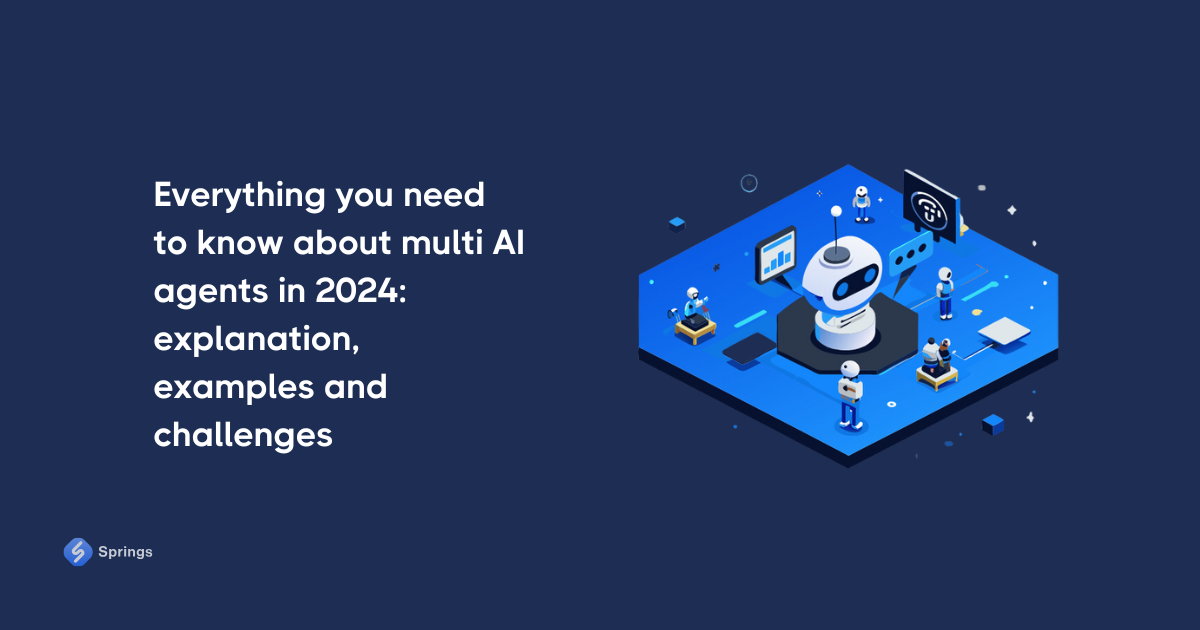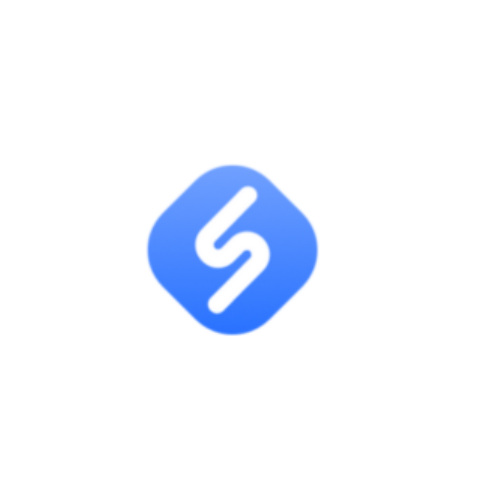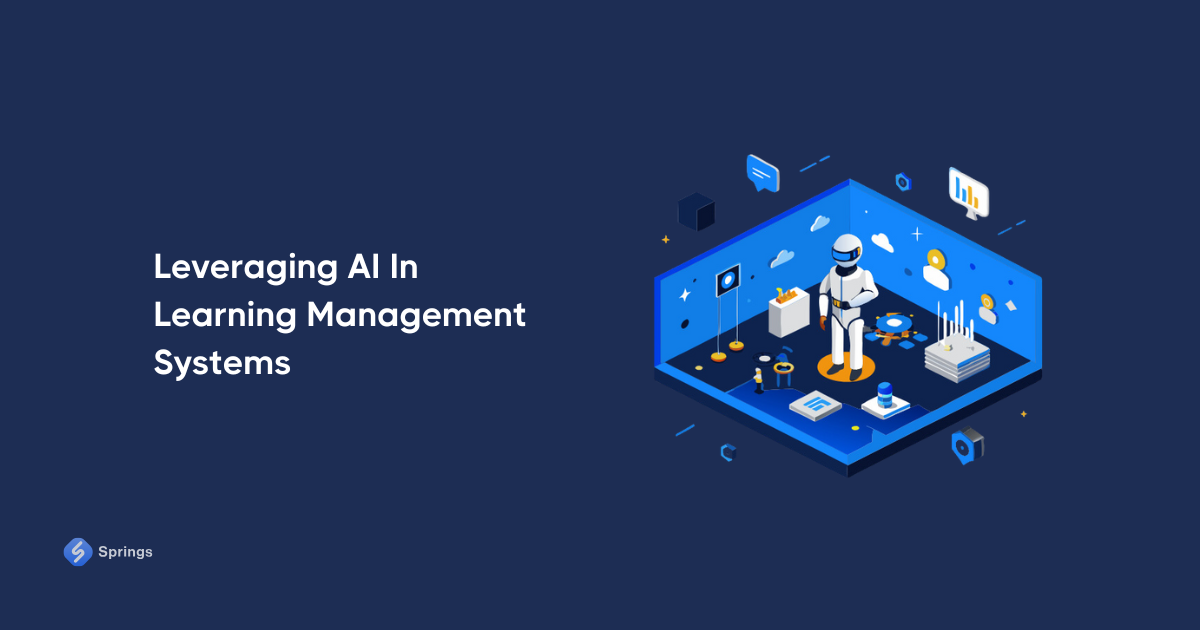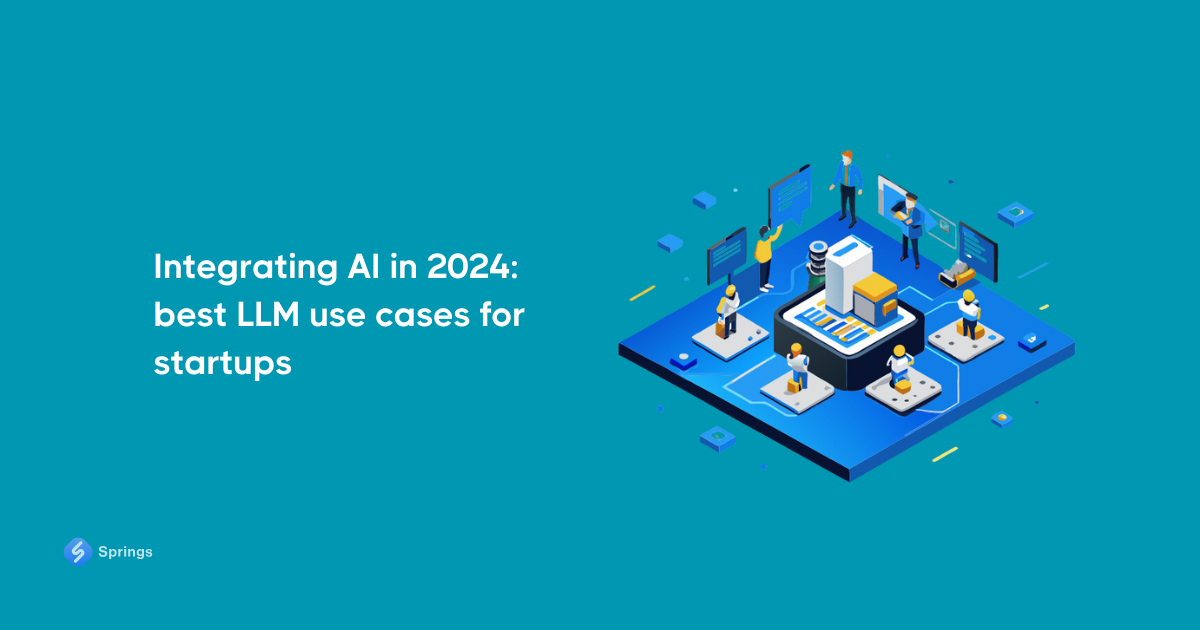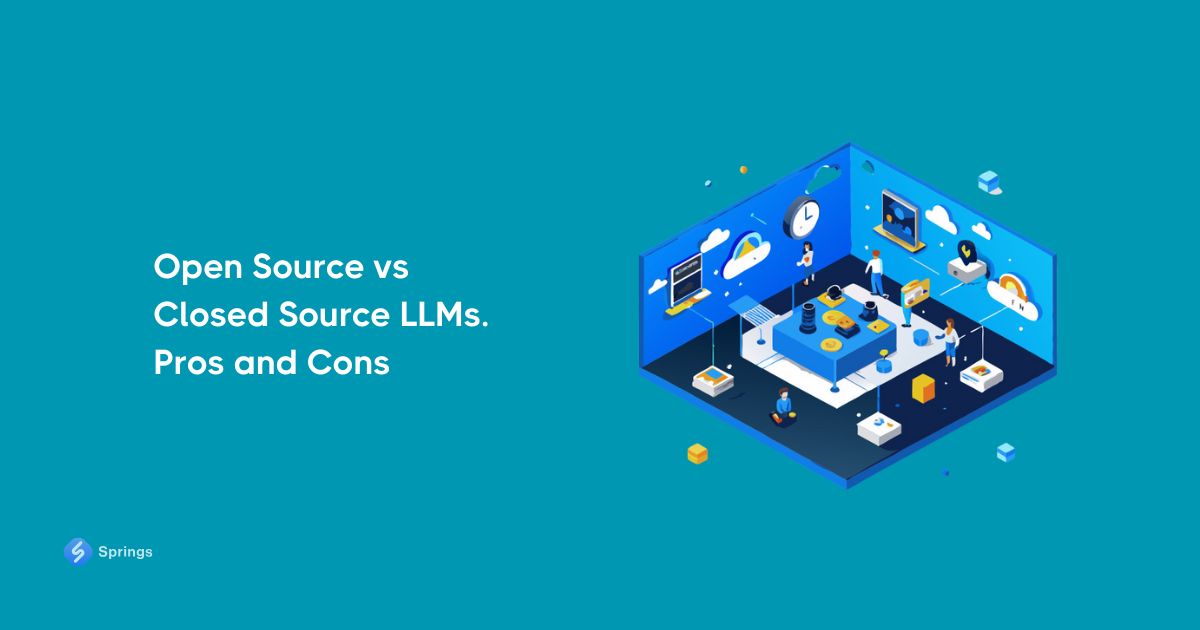Chatbot development: how to build your own chatbot
Chatbots. AI Chatbots. ChatGPT Chatbots. How many times we have heard these words in the last couple of years? According to DemandSage, the chatbot development market will reach $137.6 million by the end of 2023. Moreover, it is predicted that its value will be $239.2 million by 2025 and 454.8 million by 2027.
Obviously, chat bot services and chat bot development have become a significant part of many expert AI development companies, and Springs is not an exception. There are many chat bot examples that can be integrated into your business, starting from simple AI helpers, and finishing with complex AI Chatbot Builders.
The development of a conversational artificial intelligence platform completely depends on the specifics of your business needs and the reasons why you need chatbot customer services at all. But let’s focus on a general chat bot development process and describe, how to create an AI chat bot gpt based solution.
AI Chatbot Architecture
The general AI chatbot architecture consists of five main components (Xufei Huang):
- User Interface
- NLP Engine
- Dialogue Management
- Backend
- Response Generation
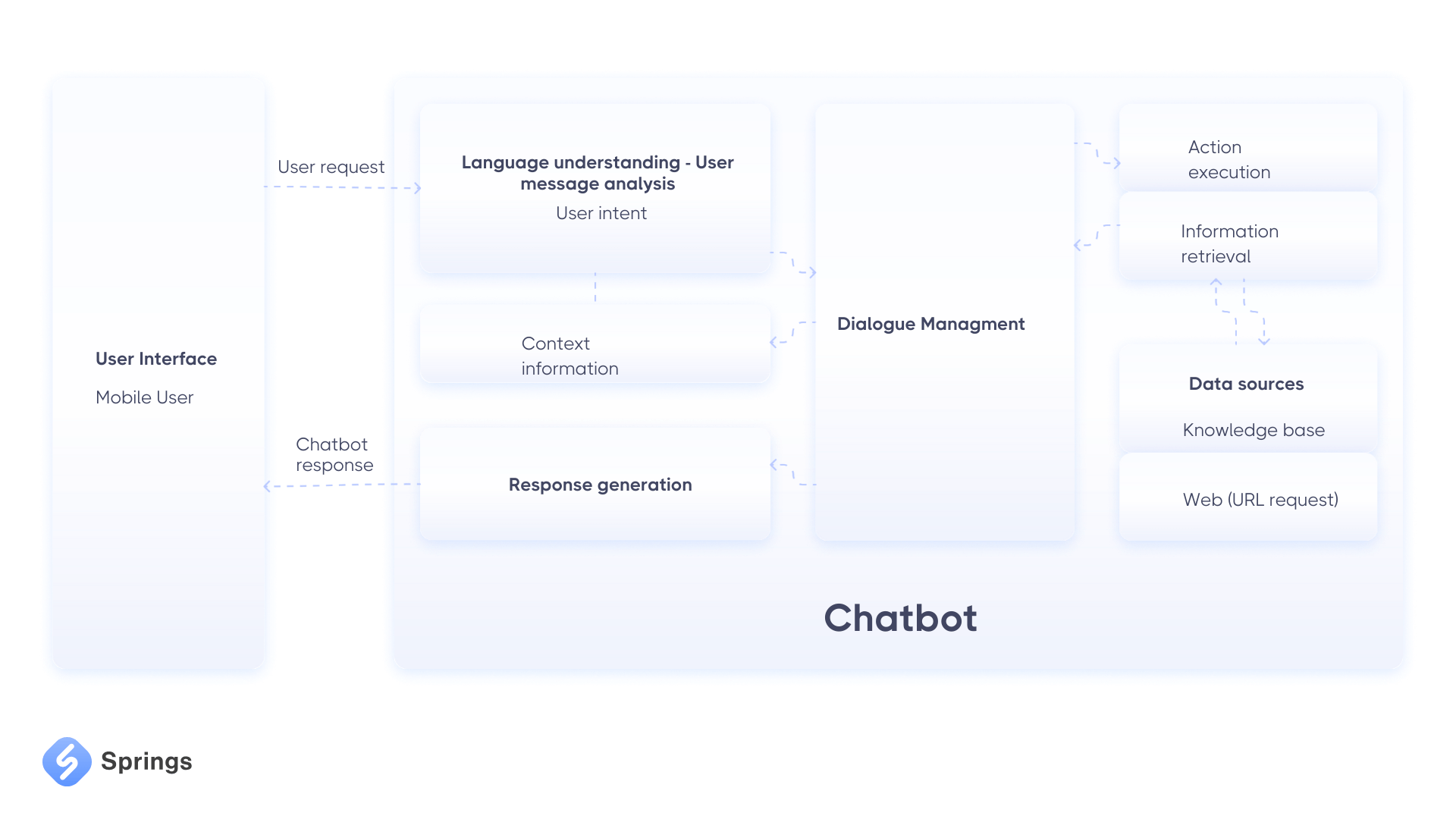
The main feature of the current AI chatbots’ structure is that they are trained using machine-learning development algorithms and can understand open-ended queries. Not only do they comprehend orders, but they also understand the language and are trained by large language models. As the AI chatbot learns from the interactions it has with users, it continues to improve. The chat bot identifies the language, context, and intent, which then reacts accordingly.
User Interface
The AI chat bot UI/UX design and development of UI could be performed in different approaches, depending on the type of AI development agency and their capabilities. At Springs, we use a custom chatbot customer service approach for the development, which helps to dive deeper into the business requirements of the needed solution and use the discovered data in the chatbot architecture planning.
This kind of approach also makes designers easier to build user interfaces and simplifies further development efforts. Here is an example of the user interface of our AI chat bot called IONI.
IONI Chatbot User Interface
The chatbot’s UI can be built using different programming languages such as Javascript, Typescript, HTML, CSS, or others. The frameworks that can be used to build a more user-friendly interface within a short period of time are as follows: React, Redux, Angular, VueJS, and jQuery. For sure, these are not the limited options to implement ai chat bot gpt front-end part so you are pretty flexible in finding the best option considering the allocated resources.
Overall, the matter is not in technology but in the performers. So, we suggest hiring experienced frontend developers to get better results and overall quality at the end of the day.
Chatbot NLP Engine
Natural Language Processing or NLP is the most significant part of bot architecture. The NLP engine interprets what users are saying at any given time and turns it into organized inputs that the system can process. Such type of mechanism uses advanced machine learning algorithms to determine the user’s intent and then match it to the bot’s supported intents list.
There are two components usually set in an NLP engine:
- Intent Classifier. The intent classifier component maps between what a user asks and the type of action performed by the software. It takes the user’s input, identifies its meaning, and relates it back to one of the intents that the chatbot supports.
- Entity Extractor. The entity extractor is a component responsible for identifying keywords from the user’s query that helps determine what the user is looking for. In other words, it is what extracts key information from the user’s query.
An NLP engine can also be extended to include a feedback mechanism and policy learning.
Feedback Mechanism. Such a mechanism includes the feedback for the chatbot provided by the users and this learning data can be integrated into the chatbot itself. So, the user rates the interaction at the end of the conversation and in this way encourages the bot to learn from its mistakes and improve.
Policy Learning. Policy learning is a specific framework where the bot is trained to create a network of happy paths in the conversation flow that increases overall end-user satisfaction.
There are many other AI technologies that are used in the chatbot development we will talk about a bot later.
Dialogue Management
Dialog Management (DM) is an important part of chat bot development flow. It involves managing and maintaining the context throughout a chatbot conversation. DM ensures that the AI chatbot can carry out coherent and meaningful exchanges with users, making the conversation feel more natural.
The DM accepts input from the conversational AI components, interacts with external resources and knowledge bases, produces the output message, and controls the general flow of specific dialogue. The general input to the DM begins with a human utterance that is later typically converted to some semantic rendering by the natural language understanding (NLU) component.
For instance, if the user is looking for booking flight tickets, an input can resemble a structure like:
ORDER(from=TLV, to=JER, date=2021-01-02)
The output of the DM is usually a list of instructions for other parts of the dialogue system to take care of, and the natural language generation (NLG) component in particular. Such kinds of instructions tend to be represented in a semantic way, such as:
OFFER (flight-num=422, flight-time=13:00),
which are then converted back to human language by the natural language generation component (Hyro).
To sum up, the dialogue management process is typically viewed through two main tasks:
- Dialogue modeling: keeping track of the dialogue state
- Dialogue control: Deciding on the next system action
DM last stage function is to combine the NLU and NLG with the task manager, so the chatbot can perform needed tasks or functions.
Backend & Response Generation
The backend and server part of the AI chatbot can be built in different ways as well as any other application. For example, we usually use the combination of Python, NodeJS & OpenAI GPT-4 API in our chat-bot-based projects. You may also use such combinations as MEAN, MERN, or LAMP stack in order to program chatbot and customize it to your requirements.
Logic
There are a couple of variations for backend logic chatbot development. For example, if you plan to implement your own custom AI algorithms, program custom text processing functions, or support multiple file types (like .csv and .xlsx), then the best option will be going with Python programming language and related stack of technologies.
In case you are planning to use off-the-shelf AI solutions like the OpenAI API, doing minimal text processing, and working with limited file types such as .pdf, then Node.js will be the faster solution.
Databases
To store and process the data of your users and different application data we need to connect the database (DB). There are two types of DBs that will be usually needed to connect to the backend: General DB and Vector DB.
- General DB. In terms of general DB, the possible choice will come down to using a NoSQL database like MongoDB or a relational database like MySQL or PostgresSQL. While both options will be able to handle and scale with your data with no problem, we give a slight edge to relational databases.
- Vector DB. The vector database is essential to AI chat bot development. Vector databases are optimized for storing and retrieving vectors: sets of numbers that combine data into embeddings. In other words, embeddings are the numerical representation of your text data, which is how the AI understands the words that are given to it.
In order to build a custom chat bot on your data, you need to convert your text data into embeddings and store it in vector databases so your data can be accessed and understood by the conversational artificial intelligence platform. The most popular vector databases for now are Pinecone, and Chroma.
LLM Integration
The brain of the chatbot is LLM backend. It can be implemented in different ways and methods. One of the easiest options to implement chat bot services is to use closed-source APIs such as OpenAI Chat API, Claude by Anthropic, Bard by Google or any other open-source LLM APIs you would like to use for your chat bot.
On the other hand, if you would like to take full control over your AI backend we suggest using either an open-source LLM or training your own LLM. This also has to be hosted and made available through an API. The difference between open and closed source LLMs, their advantages and disadvantages, we have recently discussed in our blog post, feel free to learn more.
Another important aspect of connecting LLM to the chat bot infrastructure is using Langchain. Langchain is a popular open Python and Javascript library that lets you connect your own data with the LLM that is responsible for understanding that data. It also provides a host of text processing and management functions. Without using Langchain, you need to program all these integration and processing functions from scratch.
Overall, the backend with vector database makes the core flow of AI chatbot response generation. You may see how it works on the schema below:
As we may see, the user query is processed within the certain LLM integrated into the backend. At the same time, the user's raw data is transferred to the vector database, from which it is embedded and directed ot the LLM to be used for the response generation.
The langchain lays the role of connector: both LLM, Search (as an optional feature), and VectorDB are processed by it and provide the response to the user. We have already used a similar experience at Springs while building the AI Chatbot Builder.
Hosting
Finally, we need to store our chatbot somewhere despite the fact that chat bot examples can be absolutely different. You may host the chatbot on a cloud-based platform like Amazon Web Services (AWS) or Google Cloud Platform (GCP), or on a private server depending on your needs.
We do recommend using only well-known hosting providers to avoid any security issues or potential risks.

